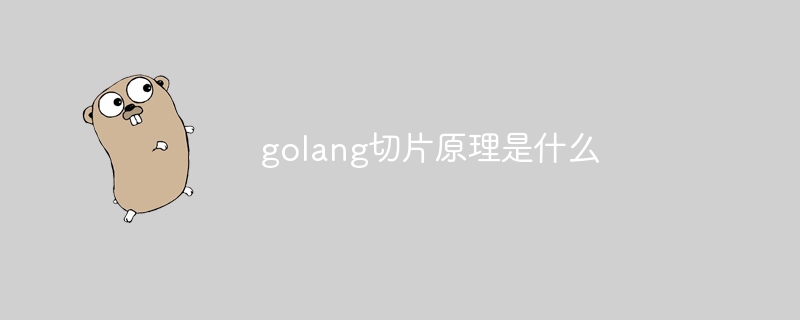
Golang slicing principle is the underlying array, length and capacity, slice expansion and slicing operations. Detailed introduction: 1. Underlying array, slicing is built on the underlying array, and the underlying array is where the elements are actually stored. The slice points to the starting position of the underlying array through a pointer; 2. Length and capacity, the length of the slice cannot exceed the capacity, but the length can be extended by appending elements until the capacity is exceeded; 3. Expansion of the slice, when the length of the slice exceeds the capacity , the slice will automatically expand; 4. Slice operations, etc.

The operating system for this tutorial: Windows 10 system, Go version 1.21, DELL G3 computer.
Slice in Go language is a dynamic array, which provides a convenient and flexible way to process arrays. The underlying principle of slicing involves concepts such as arrays, pointers, length, and capacity. Below I will introduce the principle of slicing in detail.
A slice is a reference to the underlying array, which consists of three parts: a pointer to the underlying array, length and capacity. A slice is defined as []T, where T represents the type of elements in the slice.
Specifically, the principle of slicing is as follows:
1. Underlying array: Slicing is built on the underlying array, which is where the elements are actually stored. . Slices point to the starting position of the underlying array through a pointer.
2. Length and capacity: Slices have two attributes: length and capacity. The length represents the number of elements currently contained in the slice, which can be obtained through the built-in function len(). The capacity represents the number of elements in the underlying array from the starting position of the slice to the end position of the underlying array, which can be obtained through the built-in function cap(). The length of a slice cannot exceed its capacity, but it can be extended by appending elements until it exceeds its capacity.
3. Slice expansion: When the length of the slice exceeds the capacity, the slice will automatically expand. During the expansion process, the Go language will create a new, larger underlying array and copy the original data to the new underlying array. Usually, the expansion strategy is to determine the capacity of the new underlying array according to a certain algorithm to avoid frequent memory allocation and copy operations.
4. Slicing operations: Slicing supports index access, slicing operations, append operations, etc. The element at the specified position in the slice can be obtained through index access. The index range is from 0 to the length minus 1. The slicing operation creates a new slice containing a specified range of elements from the original slice. The append operation can append one or more elements to the end of the slice. If the capacity is exceeded, expansion will be triggered.
The following is a sample code that demonstrates the basic principles and operations of slicing:
func main() {
// 创建一个切片
arr := []int{1, 2, 3, 4, 5}
// 创建切片的引用
slice := arr[1:4]
fmt.Println("切片的长度:", len(slice)) // 输出:切片的长度: 3
fmt.Println("切片的容量:", cap(slice)) // 输出:切片的容量: 4
// 修改切片中的元素
slice[0] = 9
fmt.Println("原始数组:", arr) // 输出:原始数组: [1 9 3 4 5]
fmt.Println("修改后的切片:", slice) // 输出:修改后的切片: [9 3 4]
// 追加元素到切片末尾
slice = append(slice, 6, 7)
fmt.Println("追加后的切片:", slice) // 输出:追加后的切片: [9 3 4 6 7]
fmt.Println("原始数组:", arr) // 输出:原始数组: [1 9 3 4 6 7]
// 切片的扩容
slice2 := make([]int, len(slice), 10)
copy(slice2, slice)
fmt.Println("扩容后的切片:", slice2) // 输出:扩容后的切片: [9 3 4 6 7]
fmt.Println("切片的长度:", len(slice2)) // 输出:切片的长度: 5Slicing is a convenient and powerful data structure that is used in the Go language Widely used in various scenarios. By understanding the principles and operations of slicing, you can better understand and use slicing.
The above is the detailed content of What is the principle of golang slicing?. For more information, please follow other related articles on the PHP Chinese website!




